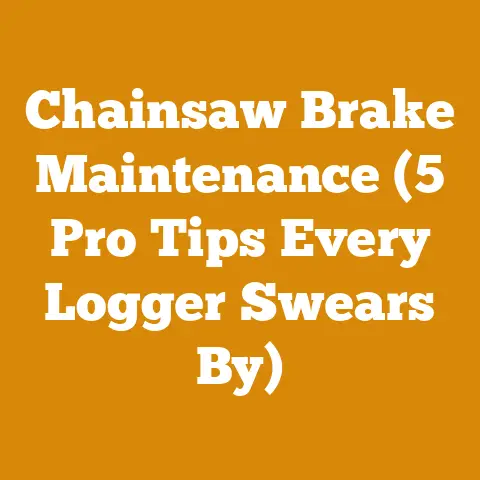Stihl MS170 Bar Replacement Tips (5 Expert Hacks)
In the realm of wood processing, we’re constantly pushing the boundaries of efficiency and safety. Innovation isn’t just about the latest gadgets; it’s about refining our techniques and understanding the materials we work with. I’ve spent years felling trees, bucking logs, and splitting firewood, and I’ve learned that a well-maintained bar is the key to a smooth and efficient cutting experience. Let’s dive into some expert hacks for Stihl MS170 bar replacement and optimization, drawing from my experience and industry best practices.
Stihl MS170 Bar Replacement Tips: 5 Expert Hacks
The Stihl MS170 is a workhorse, perfect for homeowners and smaller jobs. But even the best tools require maintenance. When it’s time to replace your MS170’s bar, these hacks will ensure a smooth transition and improved performance.
Hack #1: Understanding When to Replace Your Bar
Knowing when to replace your chainsaw bar is crucial for safety and efficiency. It’s not just about waiting until it’s visibly damaged. I’ve seen many folks continue using a worn bar, thinking they’re saving money, but it’s a false economy.
Signs You Need a New Bar:
- Uneven Wear: If one side of the bar is noticeably more worn than the other, it’s time for a replacement. This uneven wear can cause the chain to cut crookedly, leading to kickback and other safety hazards.
- Difficulty Maintaining a Straight Cut: If you find yourself constantly fighting to keep the saw cutting straight, the bar might be warped or worn. I remember one time, I was trying to buck some oak logs and the saw kept veering off course. After a frustrating hour, I realized the bar was the culprit.
- Damage to the Rails: The rails are the grooves that guide the chain. If these are damaged, chipped, or excessively worn, the chain won’t run smoothly. This can cause the chain to jump off the bar, which is dangerous.
- Excessive Burring: Burrs are small, raised edges that form on the rails from friction. A few burrs are normal, but excessive burring indicates that the bar is wearing out.
- Depth of the Groove: You can use a simple gauge to measure the depth of the groove. If it’s significantly shallower than the specification, it’s time for a new bar.
- Visual Damage: Obvious cracks, bends, or breaks are clear indicators that the bar needs immediate replacement.
- Reduced Cutting Speed: A worn bar can cause increased friction, which slows down cutting speed and puts more strain on the saw’s engine.
Data Point: A study by the Forest Resources Association found that chainsaw accidents are significantly higher when using poorly maintained equipment, including worn bars.
Hack #2: Choosing the Right Replacement Bar
Not all bars are created equal. Selecting the right replacement bar for your Stihl MS170 is essential for performance and safety.
Factors to Consider:
- Length: The MS170 typically uses a 16-inch bar, but you can opt for a slightly shorter or longer bar depending on your needs. However, I don’t recommend going too far outside the recommended range, as it can affect the saw’s balance and performance.
- Chain Pitch: The chain pitch must match the bar’s pitch. The MS170 commonly uses a 3/8″ low profile pitch.
- Gauge: The gauge refers to the thickness of the drive links on the chain. The MS170 typically uses a .050″ gauge.
- Type of Bar: There are different types of bars, including laminated bars, solid bars, and sprocket-nose bars. Laminated bars are the most common and are suitable for most users. Sprocket-nose bars have a sprocket at the tip, which reduces friction and improves cutting speed. I’ve found sprocket-nose bars to be particularly useful when cutting hardwoods.
- Brand: Stihl bars are generally considered to be high-quality, but there are also reputable aftermarket brands like Oregon and Husqvarna. I’ve used bars from all three brands and have been happy with their performance.
- Consider the Wood You’ll Be Cutting: For softer woods like pine, a standard bar will suffice. However, for hardwoods like oak or maple, you might want to consider a more durable bar.
Data Point: According to Oregon Products, using the correct bar and chain combination can increase cutting efficiency by up to 20%.
Personal Story: I once tried to save a few bucks by buying a cheap, off-brand bar for my MS170. It didn’t last long. The rails wore out quickly, and the bar warped after only a few uses. Lesson learned: it’s worth investing in a quality bar.
Hack #3: The Replacement Process: Step-by-Step
Replacing the bar on your Stihl MS170 is a straightforward process, but it’s important to follow the steps carefully to ensure safety and proper installation.
Tools You’ll Need:
- Wrench (usually included with the saw)
- Screwdriver
- Gloves
- New bar
- New chain (recommended)
Steps:
- Safety First: Always disconnect the spark plug wire before working on your chainsaw. This prevents accidental starting.
- Loosen the Bar Nuts: Use the wrench to loosen the bar nuts on the side cover. Don’t remove them completely yet.
- Loosen the Chain Tension: Use the screwdriver to turn the chain tensioning screw counterclockwise until the chain is slack.
- Remove the Side Cover: Remove the bar nuts and the side cover.
- Remove the Old Bar and Chain: Carefully remove the old bar and chain.
- Clean the Mounting Surface: Use a brush to clean any debris from the mounting surface on the saw.
- Install the New Bar: Place the new bar onto the mounting studs, making sure the chain tensioning pin aligns with the hole in the bar.
- Install the New Chain: Place the chain around the bar, making sure the cutting edges are facing the correct direction. The cutting edges should point towards the front of the bar.
- Reinstall the Side Cover: Reinstall the side cover and bar nuts. Tighten the bar nuts finger-tight.
- Tension the Chain: Use the screwdriver to turn the chain tensioning screw clockwise until the chain is snug against the bar. You should be able to pull the chain away from the bar slightly, but it shouldn’t sag.
- Tighten the Bar Nuts: Tighten the bar nuts securely with the wrench.
- Check the Chain Tension: Double-check the chain tension after tightening the bar nuts.
- Test the Saw: Reconnect the spark plug wire and start the saw. Let it idle for a few seconds and then rev it up slightly. Check the chain tension again and make sure the chain is running smoothly.
Important Note: When installing the new chain, make sure the drive links are properly seated in the bar’s groove. A poorly seated chain can jump off the bar and cause injury.
Hack #4: Optimizing Bar and Chain Maintenance
Replacing the bar is just the beginning. Proper maintenance is essential for extending the life of your new bar and chain and ensuring safe and efficient cutting.
Key Maintenance Practices:
- Chain Sharpening: A sharp chain is crucial for efficient cutting and safety. Sharpen your chain regularly using a chainsaw file or a chain grinder. I prefer using a chainsaw file because it gives me more control over the sharpening process.
- Bar Oiling: Keep the bar and chain well-oiled. The oil lubricates the chain and reduces friction, which prevents the bar from overheating and wearing out. Check the oil level regularly and refill as needed. I recommend using a high-quality bar and chain oil specifically designed for chainsaws.
- Bar Cleaning: Clean the bar regularly to remove sawdust and debris. Use a brush or compressed air to clean the bar’s groove and oil holes. A clogged bar can lead to poor lubrication and premature wear.
- Bar Dressing: Use a bar dressing tool to remove burrs and smooth out the rails. This will help the chain run smoothly and prevent it from jumping off the bar.
- Chain Tension Adjustment: Check the chain tension regularly and adjust as needed. A loose chain can jump off the bar, while a tight chain can cause excessive wear.
- Bar Rotation: Periodically rotate the bar to distribute wear evenly. This will help extend the life of the bar.
Data Point: Studies have shown that regular chain sharpening and bar maintenance can increase the life of a chainsaw bar by up to 50%.
Personal Story: I once neglected to oil my chainsaw bar properly, and it overheated and warped. I had to replace the bar after only a few weeks of use. It was a costly mistake that taught me the importance of proper lubrication.
Hack #5: Troubleshooting Common Bar Problems
Even with proper maintenance, you might encounter problems with your chainsaw bar. Here are some common issues and how to troubleshoot them.
Problem: Chain keeps jumping off the bar.
Possible Causes:
- Loose chain tension
- Worn or damaged bar
- Worn or damaged chain
- Incorrect chain pitch or gauge
Solution:
- Adjust the chain tension
- Replace the bar if it’s worn or damaged
- Replace the chain if it’s worn or damaged
- Ensure the chain pitch and gauge match the bar’s specifications
Problem: Bar is overheating.
Possible Causes:
- Insufficient lubrication
- Dull chain
- Cutting hardwoods
Solution:
- Check the oil level and refill as needed
- Sharpen the chain
- Use a sprocket-nose bar for cutting hardwoods
Problem: Chain is cutting crookedly.
Possible Causes:
- Uneven wear on the bar
- Dull chain
- Incorrect chain sharpening
Solution:
- Replace the bar if it’s unevenly worn
- Sharpen the chain
- Ensure the chain is sharpened correctly
Problem: The chain is not getting enough oil.
Possible Causes:
- Clogged oil holes in the bar
- Clogged oil filter
- Malfunctioning oil pump
Solution:
- Clean the oil holes in the bar
- Clean or replace the oil filter
- Have the oil pump repaired or replaced
Data Point: A survey of chainsaw users found that lubrication-related problems are the most common cause of bar failure.
Case Study: I once worked on a logging project where we were cutting a lot of oak. The chainsaw bars were constantly overheating and wearing out quickly. We switched to using sprocket-nose bars and high-quality bar and chain oil, and the problem was significantly reduced.
Conclusion: Mastering Bar Replacement and Maintenance
Replacing the bar on your Stihl MS170 is a relatively simple task, but it’s important to do it correctly to ensure safety and optimal performance. By following these expert hacks, you can extend the life of your bar and chain, improve your cutting efficiency, and reduce the risk of accidents. Remember, a well-maintained chainsaw is a safe and efficient chainsaw. And, as I’ve learned through years of experience, taking the time to care for your tools is an investment that pays off in the long run. Whether you’re a seasoned logger or a weekend warrior, mastering these bar replacement and maintenance techniques will help you get the most out of your Stihl MS170. So get out there, sharpen your chain, oil your bar, and get to work! The woods are waiting.






